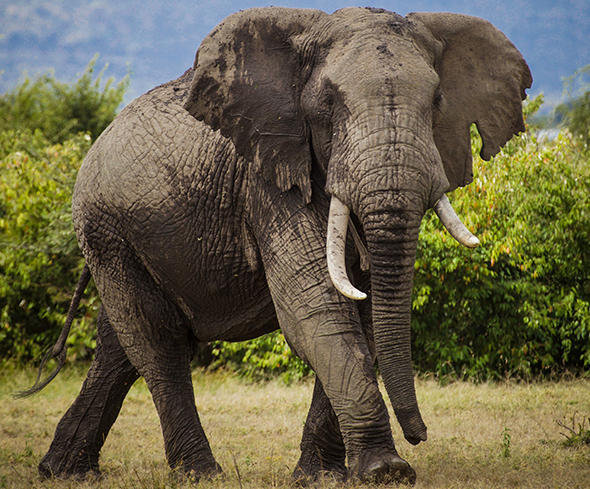
Human-elephant conflict is on the rise across Africa and poses a major threat to wildlife conservation. Crops provide a highly nutritious food source, but elephants chasing that source result in the destruction of farmers' livelihoods, eroding human tolerance for wildlife. The men end up showing their exasperation with violence and reprisals against the elephants who plunder the crops.
It was assumed that the conflicts stemming from crop destruction were mainly due to a few selected elephants, but the managers did not have the means to assess this at a more precise and detailed level. New research, however, offers the first insight into long-term trends in crop raiding behavior. Researchers have found that the usual crop raiding elephants are only part of the problem.
The study was conducted by an international team of researchers from Colorado State University, Mara Elephant Project, Grumeti Fund, Tanzania Wildlife Research Institute, Kenya Wildlife Service and Save the Elephants. It was published in the Journal of Animal Ecology.
The researchers said the findings could help conservationists better understand elephant behavior and develop new mitigation methods to reduce human-elephant conflict.
The team used the time spent in crops each year to classify the behavior of elephants involved in the destruction as follows:
- Rare , for 26% of the elephants studied.
- Sporadic, for 34 %.
- Seasonal , for 31%.
- Usual , for 9% of elephants.
Sporadic and seasonal elephants made up two-thirds of the population and accounted for 67% of agricultural raids, while habitual individuals made up only 9% of the population and accounted for 32% of crop raiding. The choice of tactics has not been consistent over time, and elephants have changed tactics frequently between years, showing how animals must balance the mortality risks and nutritional benefits of using crops and this, on a daily and annual scale. Only five of the nine elephants remained habitual raiders for consecutive years.
The habits of elephants accessing agriculture as a food source are 'remarkably consistent'
“Elephants are incredibly unique animals, and populations and individuals within herds vary greatly depending on how agriculture is used,” said Kristen Snyder, conservation scientist at CSU and the Grumeti Fund. , and co-author of the new study. “But the patterns of access to agriculture – at night and while moving quickly – are remarkably consistent across individuals and populations. »
Traditionally, researchers and managers believed that only a small contingent of elephants were responsible for the majority of raids on crops and therefore management strategies were devised to thwart them, explained Nathan Hahn, PhD student in ecology at CSU and lead author of the study.
Hahn said the team wanted to assess how this expectation aligns with the actual behavior of elephants.
“It turns out that crop raiding is much more prevalent in the study populations than we previously assumed,” he said. “Furthermore, the conflict patterns are complex because we have seen that individuals frequently change the use of their agricultural land between years. »
The research team analyzed nine years of GPS tracking data from 66 ring-necked elephants – 32 males and 34 females – in collaboration with the Kenya Wildlife Service and the Tanzania Wildlife Research Institute in the serengeti-mara ecosystem. This ecosystem is an extensive network of game reserves, parks and community reserves that straddles the border between Kenya and Tanzania.
GPS data was used to determine the extent to which each elephant used agriculture and assessed the animals' perception of risk based on the raiding tactics they used versus their daily movement patterns.
A 'quick fix' approach is elusive for a complex species
Jake Wall, director of research and conservation for the Mara Elephant Project and a csu-affiliated professor, said that by using GPS tracking coupled with remote sensing agricultural spatial information, scientists now have a method to characterize crop raiding behavior within a given elephant population.
“This in turn should help wildlife managers improve crop raid mitigation strategies,” he said.
Snyder said the results of the study can identify crop raiding mitigation strategies that could have an impact and, just as importantly, weed out those that are not appropriate for the local context.
“In the western Serengeti, the high prevalence of agricultural use among the study population indicates that strategies to individually target problem animals are unlikely to significantly reduce crop damage” , she explained.
Individual or small-scale approaches will make little difference if 80% of the local elephant population regularly uses agriculture as a food source.
"Instead, solutions that prevent elephants from accessing large-scale farms are needed," Snyder said.
CSU Professor George Wittemyer said elephants use complex, adaptive movements that balance their desire to access resources while avoiding threats. He is one of the main authors of this study and is also the chairman of the scientific council of Save the Elephants .
"This research shows how this perceived balance differs from individual to individual, but also changes over time for any given individual," Wittemyer said. “This variation underlies the difficulty of solution-focused human-elephant coexistence measures. As we often see, a silver bullet is elusive for a species as complex and intelligent as elephants. We need to be as adaptive as they are when trying to solve these problems. »
This work was supported by the National Science Foundation. Permissions for collaring and research on Tanzanian elephants have been granted by the Tanzania Wildlife Research Institute, the Tanzania Commission for Science and Technology, the Tanzania Wildlife Management Authority and the National Parks of Tanzania, and in Kenya by the Kenya Wildlife Service.
 Olchoda, whose name means 'disturber', received his collar in November 2016 from the Kenya Wildlife Service and mara Elephant Project at Pardamant Conservancy. ©Mara Elephant Project.
Olchoda, whose name means 'disturber', received his collar in November 2016 from the Kenya Wildlife Service and mara Elephant Project at Pardamant Conservancy. ©Mara Elephant Project.
Photo article : Mara Elephant project.
Posted on 2022-02-11 14:20








Comments